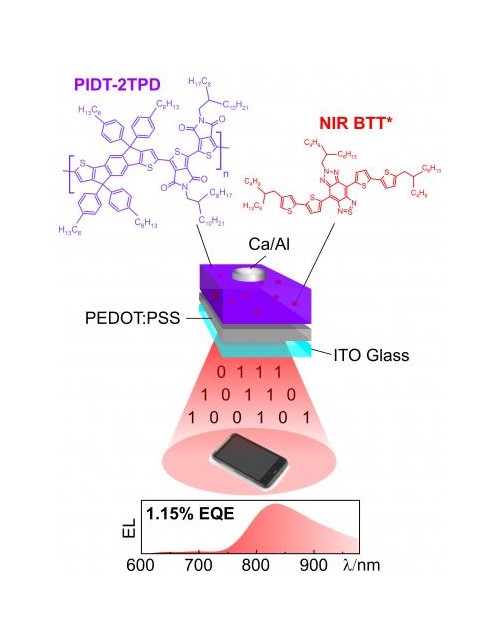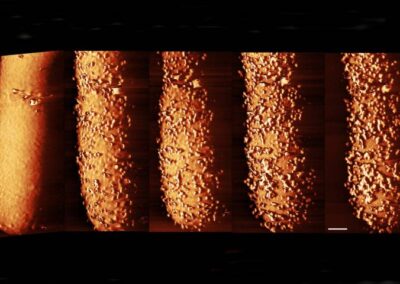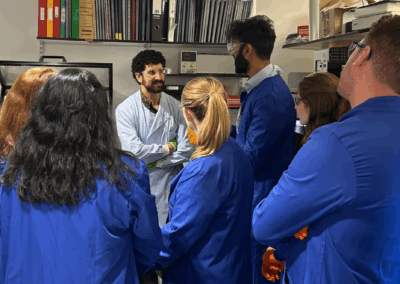Burgeoning interest for near-infrared (NIR) organic light-emitting diodes (OLEDs) is fuelled by the huge prospects for integration in a broad range of applications, spanning from “biomedics” (for sensing, bio-imaging, photodynamic therapy, optogenetics, to name just a few) to Light-Fidelity (Li-Fi) all-optical wireless telecommunications (e.g. luminaire-integrated “last metre” connection stubs), and security/biometrics.
Obtaining high efficiency from NIR fluorophores is much more challenging than for visible ones because of the inherent tendency to aggregation of large conjugated chromophores, and because of the so-called “Energy-gap rule”. To date, the highest efficiencies in the NIR have been obtained from OLEDs incorporating phosphorescent emitters or, more generally, materials exploiting triplet excited states. However, the long triplet lifetime (microseconds at least) limits the OLEDs switching speed (e.g. in Li-Fi). Furthermore, the toxicity of heavy metals in phosphorescent materials also raises biocompatibility concerns for applications in wearable or “skin” electronics.
In a recent paper published in Advanced Materials, researchers from the London Centre for Nanotechnology and the Department of Physics and Astronomy at UCL, alongside with collaborators from Chalmers University of Technology (Sweden), Addis Ababa University (Ethiopia) and Flinders University (Australia), have demonstrated unprecedented efficiencies from NIR OLEDs based on a purely organic fluorescent active layer emitting above 800 nm.
To achieve such an advance, authors leveraged a newly designed and synthesised triazolobenzothiadiazole-based NIR emitter (BTT*), which was blended in a novel indacenodithiophene-based transport polymer matrix (PIDT-2TPD). Thanks to the optimal transport properties of the polymer matrix, and the spectral overlap between the emission of the polymer matrix and the absorption of the NIR guest, such a blend exhibits virtually pure NIR electroluminescence peaked at 840 nm, external electroluminescence quantum efficiencies in excess of 1.15 % and turn-on voltages as low as 1.7 V. For this spectral range, such values are the best ever reported from NIR OLEDs with purely organic and solution-processed active layers.
Fluorescent materials such as BTT* are desirable for both bio-medical applications because free from heavy metals, and for Li-Fi applications since intrinsic fluorescence lifetimes (1 ns or so), as they make it theoretically possible to extend the data transmission rate up to the Gb/s regime.
Figure: NIR OLED structure, with the PIDT-2TPD:BTT* blend sandwiched between a Ca/Al and ITO/PEDOT:PSS electrodes. The electroluminescence spectrum measured from the PIDT-2TPD:BTT* OLED is also shown. Note the NIR purity of the spectrum, with 99 % of photons emitted at λ > 700 nm and maximum at 840 nm
The research paper can be read in full: Efficient Near-Infrared Electroluminescence at 840 nm with “Metal-Free” Small-Molecule:Polymer Blends, Advanced Materials
Related links:-
Chalmers University of Technology
Embargo Date: Thu, 12/07/2018 – 12:38


